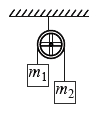किसी नाभिकीय अभिक्रिया A+b→C+d का Q -मान निम्नलिखित समीकरण द्वारा परिभाषित होता है-
Q=[mA+mb−mc−md]c2
जहाँ दिए गए द्रव्यमान, नाभिकीय विराम द्रव्यमान (Restmass) है। दिए गए आँकड़ों के आधार पर बताइए कि निम्नलिखित अभिक्रियाएँ ऊष्माक्षेपी है या ऊष्माशोषी -
11H+31H→21H+21H
Q=[m(11H)+m(31H)−m(21H)−m(21H)]c2
=[1.007825+3.016049−2.014102−2.014102]uc2
=[4.023874−4.0282204]×931.5MeVc2×c2
=−0.00433×931.5MeV
=−4.033MeV
ऊर्जा ऋणात्मक है। अतः अभिक्रिया ऊष्माशोषी है।
Topper's Solved these Questions
Similar Questions
रेडियोऐक्टिव तत्व की औसत आयु के दौरान अंश जो विघटित होता है-
View Solutionकिसी नलिका से बहने वाले द्रव का क्रांतिक वेग की विमाओ को (ηx,ρyrz)से निर्दिष्ट किया जाता है , जहाँ η,ρतथा r क्रमशःद्रव का श्यानता गुणांक , द्रव का घनत्व तथा नली की त्रिज्या है । x,y,zके मान क्रमशःहोंगे -
View Solutionहाइड्रोजन परमाणु की आयनन-ऊर्जा 13.6 eV है। एक फोटॉन किसी हाइड्रोजन परमाणु पर जो प्रारम्भ में निम्नतम ऊर्जा अवस्था में है, गिरता है और उसे n = 4 अवस्था तक उत्तेजित करता है। फोटॉन की तरंगदैर्घ्य की गणना कीजिए। (h=4.14×10−15eV−s तथा c=3.0×108 मीटर / सेकण्ड)
View SolutionThe lines y=m1x,y=m2xandy=m3x make equal intercepts on the line x+y=1. Then (a) 2(1+m1)(1+m3)=(1+m2)(2+m1+m3) (b)(1+m1)(1+m3)=(1+m2)(1+m1+m3) (c)(1+m1)(1+m2)=(1+m3)(2+m1+m3) (d)2(1+m1)(1+m3)=(1+m2)(1+m1+m3)
View SolutionIf y=m1x+c and y=m2x+c are two tangents to the parabola y2+4a(x+a)=0 , then (a)m1+m2=0 (b) 1+m1+m2=0 (c)m1m2−1=0 (d) 1+m1m2=0
View SolutionThe area of the triangle formed by the lines y=m1x+c1,y=m2,x+c2andx=0 is 12(c1+c2)2|m1−m2| b. 12(c1−c2)2|m1+m2| c. 12(c1−c2)2|m1−m2| d. (c1−c2)2|m1−m2|
View SolutionExplain , giving reason , which of the following sets of quantum number are not possible an=0l=0m1=0ms=+1/2bn=1l=0m1=0ms=−1/2cn=1l=0m1=0ms=+1/2dn=2l=1m1=0ms=−1/2en=3l=3m1=−3ms=+1/2fn=3l=1m1=0ms=+1/2
View SolutionConsider three blocks of masses m_(1),m_(2),m_(3) interconnected by strings which are pulled by a common force F on a frictionless horizontal tabel as in the figure. The tension T_(1) and T_(2) are also indicated . a) T_(2)gtT_(1) if m_(2)gtm_(1) b) T_(2)=T_(1) if m_(2)=m_(1) , c) T_(2) gt T_(1) always d) acceleration of the system (F)/(m_(1)+m_(2)+m_(3)) .
View Solutionकिसी नाभिकीय अभिक्रिया A+b→C+d का Q मान निम्नलिखित समीकरण द्वारा परिभाषित होता है।
Q=[mA+mb−mC−md]c2
जहां दिए गए द्रव्यमान नाभिकीय विराम द्रव्यमान है। दिए गए आंकड़ों के आधार पर बताइए कि निम्नलिखित अभिक्रियाएं ऊष्माक्षेपी है या ऊष्माशोषी।
(i) .11H+.31H→21H+.21H
(ii) .6.12C+.126C→.2010Ne+.42He
दिए गए परमाणु द्रव्यमान इस प्रकार है:
m(.21H)=2.014102u
m(.31H)=3.016049u
m(.126C)=12.000000u
m(_(10)20Ne)=19.992439u
View Solutionसूत्र (m1x2+m2x1m1+m2,m1y2+m2y1m1+m2) क्या कहलाता है ?
View Solutionनिम्नलिखित अभिक्रिया के लिए अभिक्रिया का औसत वेग बताइये-
m1A+n2B→m1C+m2D
View SolutionThe Q value of a nuclear reaction A+b to C+d is defined by Q=[m_(A)+m_(b)-m_(C )-m_(d)]c^(2) where the masses refer to the respective nuclei. Determine from the given data the Q-value of the following reactions and state whether the reactions are exothermic or endothermic. ._(1)^(1)H+ ._(1)^(3)H to ._(1)^(2)H+._(1)^(2) Atomic masses are given to be m(._(1)^(2)H)=2.014102 u m(._(1)^(3)H)=3.016049 u m(._(6)^(12)C)=12.000000 u m(._(10)^(20)Ne)=19.992439 u
View SolutionTwo masses m1 and m2(m2>m1) are hanging vertically over frictionless pulley. The acceleration of the two masses is :

View SolutionConsider three blocks of masses m_(1), m_(2), m_(3) interconnected by strings which are pulled by a common force F on a frictionless horizontal table as in the figure. The tension T_(1) and T_(2) are also indicated a) T_(2) gt T_(1)" if "m_(2) gt m_(1) b) T_(2) =T_(1)" if "m_(2)=m_(1) c) T_(2) gt T_(1) always d) "acceleration of the system"=(F)/(m_(1)+m_(2)+m_(3))
View SolutionIn triangle ABC m1,m2,m3 are the lenghts of the medians through A,B and C respectively . If C=π2, then m21+m22m23=
View SolutionExplain , giving reason , which of the following sets of quantum number are not possible an=0l=0m1=0ms=+1/2bn=1l=0m1=0ms=−1/2cn=1l=1m1=0ms=+1/2dn=2l=1m1=0ms=−1/2en=3l=3m1=−3ms=+1/2fn=3l=1m1=0ms=+1/2
View Solution
